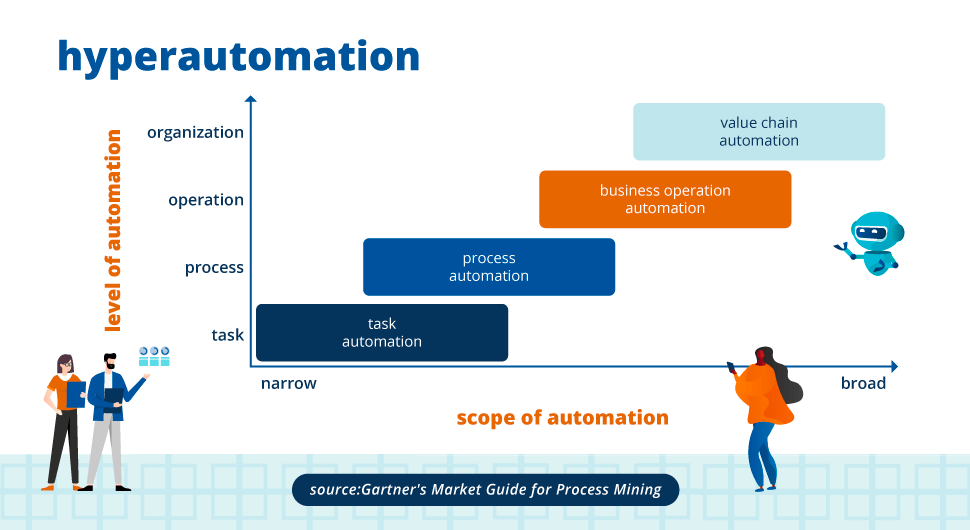What is Process Mining?
Discover what process mining is and why it’s a critical step in hyperautomation.

Knowledge is Power: Gartner on Process Mining
If you had the ability to identify and address potential problems in your organization before they became larger issues, wouldn’t you jump at it?
Process Mining is a process discovery tool that allows businesses to gain insight into their underlying processes to understand where to improve and make smarter, faster decisions — and this checks out: 78% of people who automate say that Process Mining is key to enabling their RPA efforts.
A leader in research and business insights, Gartner answers the question, “What is Process Mining?” and show exactly why it’s a critical step in enterprise-wide automation.
What Exactly is Process Mining?
Think of Process Mining like routine car maintenance. Just as you take your car in for regular oil changes and check-ups, you also want to routinely check up on your internal business processes. Every so often, you want to check under the hood for operational inefficiencies.
Traditionally, operational checkups equate to a lengthy manual discovery process that involves interviewing employees and reviewing data from process records, documentation, technology systems, and employee tasks. It can be time-consuming, costly, and often limited in its findings, as documentation may be incomplete or employees unresponsive during the process.
Process Mining, on the other hand, is an automated discovery tool that runs itself, pulling data from existing information systems or event logs to monitor real processes. Using this data, businesses can then pinpoint bottlenecks and identify areas to improve and streamline.
In other words, Process Mining is like a blueprint or x-ray of a company’s operations, and a fundamental first step to take before a business automates.
Why Your Organization Should Care About Process Mining
According to Gartner, by 2022, 90% of organizations are expected to have adopted RPA. Yet, organizations who try to scale their RPA efforts fail 97% of the time. This is because it’s not just enough to have an RPA strategy in place but a plan to continue to scale and grow as well.
Gartner’s report suggests that in using Process Mining, businesses can take their automation strategies to the next level by enabling them to explore use cases and opportunities beyond traditional internal process discovery. For example, Process Mining can target interactions with customers to explore how customer interactions align with internal business operations. This can in turn help organizations deliver a more impactful customer experience and improve customer retention.
Furthermore, Process Mining can lead to organizational resilience by continuously seeking out and isolating operational data regardless of how often the data changes.
In short, Process Mining is not just about checking “under the hood”. It’s about preparing your business long term for staying resilient as processes change and evolve over time.

Key Takeaways
According to a recent Ernst and Young report, 81% of organizations believe that data should be at the core of all decision-making. The inherent challenge with this though is sifting through this data to extract what is most important.
Process Mining will not only help you sift through your business data but also analyze it. Obtaining data is one thing but knowing what to do with it next to drive business transformation and optimization is another thing entirely.
Other key takeaways from Gartner’s report include:
- Gartner introduces and popularizes the term “hyperautomation” as the universal term to describe automation across all facets of an organization. Hyperautomation refers to the integration of task automation, process automation, business operation automation, and value chain automation so that automation is implemented enterprise wide. More specifically, Gartner describes hyperautomation as: “As no single tool can replace humans, hyperautomation today involves a combination of tools, including robotic process automation (RPA), intelligent business management software (iBPMS) and AI, with a goal of increasingly AI-driven decision making.”
- Process Mining has moved into other more advanced capabilities, including conformance checking (monitoring deviations by comparing model and log), productivity improvement, and social networks.
- The five main drivers for adoption of process mining include:
- Digital transformation
- Artificial intelligence
- Task automation (RPA)
- Hyperautomation
- Operational resilience
- Five use cases for Process Mining include:
- Discovery and analysis
- Auditing and compliance
- Automation
- Digital transformation
- IT processes
In Conclusion: Automation is the Future of Digital Transformation
Since the publication of Gartner’s report, the advent of their concept “hyperautomation” has skyrocketed. It is no longer simply a technological trend to watch out for but rather a fundamental business concept and approach that organizations are widely adopting, with the worldwide market for technology that enables hyperautomation predicted to reach $596.6 billion in 2022.
As the point where AI, Machine Learning (ML), Business Process Management (BPM), Integration Platforms as a Service (iPaaS), and other emerging analytic technologies all intersect – with RPA at the core – hyper-automation is an ideal solution for rule-based processes that:
- Are document-based, taking in and storing large quantities of unstructured information
- Require data to be integrated across departments and legacy systems
- Contain highly sensitive business, customer, and process information
Additionally, leadership is beginning to understand that they need to broaden the scope of their thinking when it comes to automation. A recent survey revealed that CFOs are increasingly turning to Process Mining to unlock more returns from their investment. This is because Process Mining isolates processes in real-time, drawing out inefficiencies as well as more opportunities for automation, making it an ideal tool for scaling an automation practice.
While it is easy to see how leveraging the multitude of technologies that make up hyperautomation can be a boon to your organization’s existing automation strategy, it’s about the right combination of technologies and the right partner.
